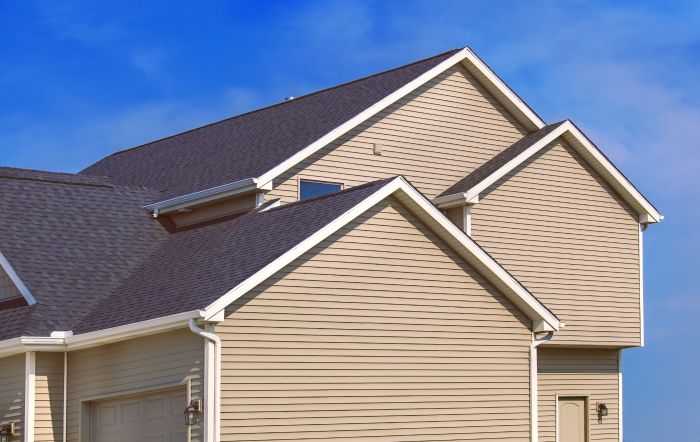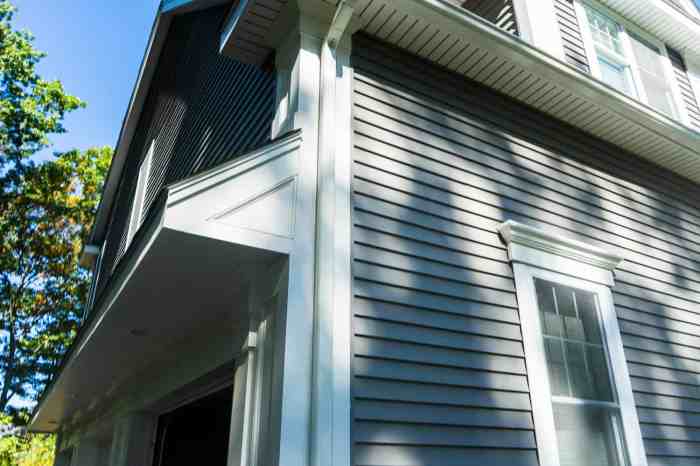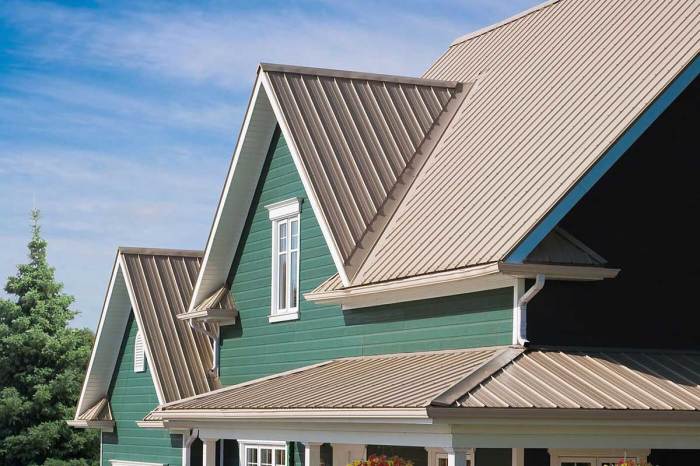Exploring the Significance of Siding on Roof

Siding on roof sets the stage for this enthralling narrative, offering readers a glimpse into a story that is rich in detail and brimming with originality. From protection to aesthetics, the role of siding is crucial in maintaining the integrity and beauty of a building.
Let's dive into the world of siding on roofs and uncover its many facets.
When it comes to safeguarding your roof and enhancing the visual appeal of your property, quality siding plays a pivotal role.
Importance of Siding on Roof

Siding plays a crucial role in protecting the roof of a building from harsh weather conditions, such as rain, snow, and wind. It acts as a shield, preventing water from seeping into the structure and causing damage.
Enhancing Aesthetics
Siding also contributes to the overall aesthetics of a building, enhancing its curb appeal and increasing property value. With a wide range of colors, textures, and materials available, siding can be customized to complement the architectural style of the building.
Benefits of Quality Siding
- Improved insulation: Quality siding can help regulate indoor temperatures, reducing energy costs.
- Durability: High-quality siding is resistant to rot, decay, and pests, providing long-lasting protection for the roof.
- Low maintenance: Quality siding requires minimal upkeep, saving time and money in the long run.
- Increased property value: Well-maintained siding can enhance the overall value of a property and attract potential buyers.
Types of Siding Materials

When it comes to siding materials for roofs, there are several options available, each with its own benefits and considerations. Here, we will explore common siding materials used, compare their durability, and discuss maintenance requirements.
Asphalt Shingles
Asphalt shingles are one of the most popular siding materials due to their affordability and ease of installation. They are relatively durable, with an average lifespan of 15-30 years depending on the quality. However, they may require occasional maintenance such as replacement of damaged shingles.
Metal Roofing
Metal roofing, such as steel or aluminum, is known for its longevity and durability, lasting up to 50 years or more. It is resistant to fire, mildew, and pests, making it a low-maintenance option. However, it can be more expensive upfront compared to other materials.
Wood Shingles
Wood shingles offer a natural and rustic look to roofs but require more maintenance to prevent rot, mold, and insect infestations. With proper care, wood shingles can last around 20-30 years. Regular inspections and treatments are recommended to prolong their lifespan.
Vinyl Siding
Vinyl siding is a popular choice for its affordability, versatility, and low maintenance requirements. It is resistant to moisture, fading, and pests, making it a durable option with a lifespan of 20-40 years. Cleaning with a mild detergent and water is usually sufficient to maintain its appearance.
Fiber Cement
Fiber cement siding is a composite material that offers the look of wood but with better durability and lower maintenance needs. It is resistant to fire, moisture, and pests, lasting up to 50 years or more. Periodic painting may be required to keep it looking fresh.
Installation Process
When it comes to installing siding on a roof, there are several important steps to follow to ensure a proper and secure installation. Proper installation is crucial for the longevity and performance of the siding, as well as the overall structural integrity of the roof.
Preparation and Planning
- Begin by preparing the roof surface, ensuring it is clean, dry, and free of any debris or obstacles that could interfere with the siding installation.
- Measure and cut the siding materials to fit the dimensions of the roof, taking into account any angles, corners, or other unique features of the roof.
- Plan the layout of the siding to ensure a symmetrical and visually appealing installation.
Installation Steps
- Start by attaching a starter strip along the bottom edge of the roof to provide a secure base for the siding panels.
- Install the siding panels from the bottom up, ensuring each panel overlaps the one below it to prevent water infiltration.
- Secure the siding panels in place using nails or screws, following the manufacturer's guidelines for spacing and fastener placement.
- Finish the installation with trim pieces along the edges and corners of the roof for a clean and polished look.
Tips for a Proper Installation
- Follow the manufacturer's instructions and guidelines for installing the specific type of siding material you are using.
- Use high-quality fasteners and tools to ensure a secure and long-lasting installation.
- Check for proper ventilation and drainage to prevent moisture buildup and potential damage to the roof and siding.
Common Challenges
- Uneven or damaged roof surfaces can make installation more challenging, requiring additional preparation and adjustments.
- Incorrect measurements or cuts can lead to gaps or uneven seams in the siding, compromising its effectiveness and aesthetic appeal.
- Adverse weather conditions, such as high winds or rain, can disrupt the installation process and compromise the integrity of the siding.
Maintenance and Repairs
Proper maintenance of siding on a roof is essential to prolong its lifespan and ensure the protection of your home. Regular inspections and timely repairs can help prevent more significant issues down the line.
Maintenance Tips
- Regularly inspect the siding for any signs of damage, such as cracks, holes, or loose panels.
- Clean the siding at least once a year to remove dirt, debris, and mold that can cause deterioration.
- Trim any overhanging tree branches that may damage the siding during high winds or storms.
- Check for proper sealing around windows, doors, and other openings to prevent water infiltration.
Signs of Damage
- Cracks or holes in the siding.
- Loose or missing panels.
- Signs of mold or mildew growth.
- Water stains on the interior walls or ceiling.
Repair Process
If you notice any damage to the siding on your roof, it's essential to address it promptly to prevent further issues. Here is a general process for repairing damaged siding:
- Inspect the extent of the damage and determine if a repair or replacement is needed.
- Clean the area around the damaged siding to remove any debris or dirt.
- Apply a suitable sealant or patching material to cover cracks or holes in the siding.
- If the damage is extensive, consider replacing the damaged section with new siding to ensure proper protection.
Closing Notes

As we conclude this exploration of siding on roof, it becomes clear that this often-overlooked element is a key player in the longevity and appearance of a building. By understanding the importance, types, installation process, and maintenance of siding, homeowners can make informed decisions to protect their roofs for years to come.
Question & Answer Hub
What are the benefits of having quality siding on a roof?
Quality siding provides protection to the roof, enhances the aesthetics of a building, and increases its value.
What are some common materials used for siding on roofs?
Common materials include vinyl, wood, fiber cement, and metal.
How can one maintain siding to prolong its lifespan?
Regular cleaning, inspections for damage, and prompt repairs can help extend the lifespan of siding on a roof.
What are common signs of damage on roof siding?
Signs of damage include warping, cracking, fading, mold growth, and loose panels.
What is the process of repairing damaged siding on a roof?
Repairing damaged siding involves identifying the extent of damage, removing the damaged section, and replacing it with new siding.

